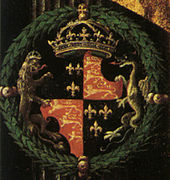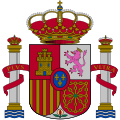| Part of a series on |
| Heraldic achievement |
|---|
| External devices in addition to the central coat of arms |



In heraldry, supporters, sometimes referred to as attendants, are figures or objects usually placed on either side of the shield and depicted holding it up.
Contents
- Attitude
- Regional development and entitlement
- Australia
- Canada
- France
- New Zealand
- Spain
- United Kingdom
- Examples
- See also
- References
Historically, supporters were left to an individual's free choice and were assumed and changed at will, not always having any meaning whatsoever. [1] In more modern times, restrictions have been put in place in certain countries and nowhere more prevalent than in the United Kingdom. [1]
Early forms of supporters are found in medieval seals. However, unlike the coronet or helmet and crest, supporters were not part of early medieval heraldry. As part of the heraldic achievement, they first become fashionable towards the end of the 15th century, but even in the 17th century were not necessarily part of the full heraldic achievement (being absent, for example, in Siebmachers Wappenbuch of 1605).
The figures used as supporters may be based on real or imaginary animals, human figures, and in rare cases plants or other inanimate objects, such as the pillars of Hercules of the coat of arms of Spain. Often, as in other elements of heraldry, these can have local significance, such as the fisherman and the tin miner granted to Cornwall County Council, or a historical link; such as the lion of England and unicorn of Scotland in the two variations of the coat of arms of the United Kingdom. The arms of nutritionist John Boyd-Orr use two 'garbs' (wheat sheaves) as supporters; the arms of USS Donald Cook, missiles; the arms of the state of Rio Grande do Norte in Brazil, trees. [2] Letters of the alphabet are used as supporters in the arms of Valencia, Spain. Human supporters can also be allegorical figures, or, more rarely, specifically named individuals. [3]
There is usually one supporter on each side of the shield, though there are some examples of single supporters placed behind the shield, such as the imperial eagle of the coat of arms of the Holy Roman Empire. The coat of arms of the Republic of the Congo provide an extremely unusual example of two supporters issuing from behind the shield. [4] While such single supporters are generally eagles [5] with one or two heads, there are other examples, including the cathedra in the case of some Canadian cathedrals. [6] At the other extreme and even rarer, the Scottish chief Dundas of that Ilk had three supporters: two conventional red lions and the whole supported by a salamander. The coat of arms of Iceland even has four supporters. [7]
The context of the application of supporters may vary, although entitlement may be considered conditioned by grant of a type of augmentation of honour by admission in orders of chivalry or by heraldic authorities, such as in the case of traditional British heraldry.
















